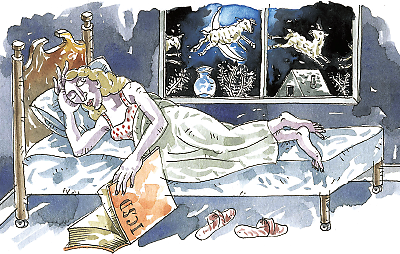Manual Updates Sleep Disorder Diagnoses
Abstract
A new manual that updates the classification of sleep disorders rethinks the concept of insomnia and addresses a range of comorbid psychiatric illnesses as well as the effects of psychiatric drugs on sleep.
Insomnia is insomnia is insomnia, according to the third edition of the International Classification of Sleep Disorders (ICSD-3), published in June by the American Academy of Sleep Medicine. The old distinction of chronic insomnia as either primary or, more often, secondary to psychiatric, substance abuse, or other medical disorders is gone.

Viewing insomnia mainly as a symptom of another disorder prompted many clinicians to direct the bulk of their treatment efforts at the so-called primary disorder, said ICSD-3 Editor Michael Sateia, M.D., a professor of psychiatry emeritus at Dartmouth’s Geisel School of Medicine.
Insomnia coexists with many disorders, and symptoms overlap, said Sateia, who also edited the previous edition, published in 2005. “Distinguishing cause and effect is difficult, if not impossible,” he said.
As many as half of patients successfully treated for depression, for example, continue to sleep poorly, increasing the odds their depression will return. Chronic insomnia itself is a significant risk factor for developing depression.
To achieve optimal treatment outcomes in people with both a psychiatric disorder and insomnia, the clinician needs to target both disorders, Charles Reynolds III, M.D., chair of the DSM-5 Sleep-Wake Disorders Work Group, told Psychiatric News.
For someone with both depression and insomnia, said Sateia, who served as a consultant to Reynolds’ group, adding a hypnotic or cognitive-behavioral treatment for insomnia (CBTI) to antidepressant treatment usually improves sleep and mood more robustly than relying on an antidepressant alone.
Both ICSD-3 and DSM-5, Reynolds said, place all insomnia diagnoses in a single insomnia category, with high convergence between these manuals.
Sleep medicine offers psychiatrists opportunities to practice behavioral treatment, psychotherapy, and psychopharmacology and to deal with a wide range of disorders with psychological ramifications, Michael Sateia, M.D., a professor of psychiatry at Dartmouth’s Geisel School of Medicine, told Psychiatric News.
This rapidly evolving field also offers multidisciplinary research possibilities, he said.
The sleep disorders program at Dartmouth is part of the Department of Psychiatry, Sateia noted. Of its two fellows each year, usually at least one is a psychiatrist.
Some 231 psychiatrists are among the 8,655 members of the American Academy of Sleep Medicine.
Criteria include a predominant complaint of dissatisfaction with sleep quantity or quality despite adequate opportunity for sleep. Daytime distress or impairment in work, family, academic, and other vital areas of functioning account for another key component. Other symptoms that commonly accompany insomnia include mood disturbance and irritability, anergia, and, especially in children, behavior problems such as hyperactivity, impulsivity, or aggression.
ICSD-3 and DSM-5 both distinguish between short-term and chronic insomnia, with the latter continuing for three months or longer. About 10 percent of the population reports chronic insomnia.
ICSD-3 represents consensus opinion from more than 100 sleep specialists worldwide. The 383-page manual covers more than 60 discrete disorders, Sateia said, many pertinent to psychiatry. It also addresses psychiatric medications that may worsen or trigger sleep disorders.
About 30 percent to 50 percent of people with obstructive sleep apnea (OSA) report fatigue, apathy, and other mood disturbances that mimic or complicate treatment of depression.
Some antidepressants exacerbate OSA’s most common presenting symptom, sleepiness, and cause weight gain that worsens OSA, Sateia noted, adding that as many as 50 percent of people with chronic schizophrenia have OSA.
People with narcolepsy have an increased prevalence of depressive and anxiety disorders, Sateia said, and symptoms of these disorders may prompt the individual to first see a psychiatrist. Some 20 percent of people with narcolepsy report panic attacks or social phobias. Reports of inattentiveness, lack of energy, insomnia, and bizarre hallucinations, particularly in children and adolescents with narcolepsy, may lead to a misdiagnosis of schizophrenia or depressive disorders, he noted.
“Asking patients with excessive sleepiness if they snore, experience abrupt loss of muscle tone or hallucinations at sleep onset, or doze involuntarily,” Sateia said, “can help uncover sleep disorders.”
Psychiatric disorders also occur in 5 percent to 7 percent of people with hypersomnia. Such individuals report daily episodes of an irrepressible need to sleep, or lapses into sleep, persisting at least three months. As these people often focus on their sleep concerns, psychiatric symptoms may become apparent only after prolonged interviews or psychometric testing.
Psychiatric conditions associated with hypersomnia include mood disorders, conversion or undifferentiated somatoform disorder, and, less commonly, schizoaffective disorder, adjustment disorder, and personality disorders. About half of individuals with seasonal affective disorder also report hypersomnia.
In people with major depressive disorder, hypersomnolence often persists even after the depression lifts, increasing the risk of recurrence.
Circadian-rhythm sleep disorders also have implications for psychiatry, Sateia said. People with delayed sleep-wake phase disorder (DSWPD), for example, complain of difficulty falling asleep and getting up at times that make it difficult to obtain enough sleep to perform well at school or work. Some use alcohol, sedatives, hypnotics, or stimulants to combat insomnia or excessive sleepiness. In adolescents, school avoidance, social maladjustment, and family dysfunction may be contributing factors.
“Even in healthy adolescents, early school start times fly in the face of normal chronobiological development,” Sateia pointed out. In those struggling with psychiatric disorders, DSWPD intensifies stress. At Dartmouth, he said, “we often negotiate delayed school start times for adolescents with significant sleep-wake delay issues.”
An often-trivialized cause of irritability, difficulty concentrating, reduced vigilance, distractibility, decreased motivation, lack of energy, and disturbed mood has its own category in ICSD-3: insufficient sleep syndrome.
People with this syndrome, common in our 24-hour society, intentionally curtail sleep for work, social, family, or other reasons. Some abuse stimulants or other substances to stay awake. According to ICSD-3, a practical, effective remedy does exist: more sleep. ■
ICSD-3 ordering information can be accessed here.



